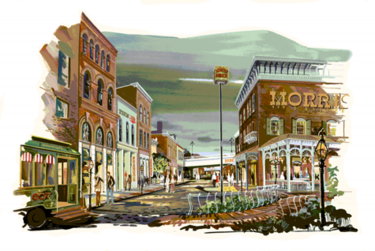Old Town Uptown
Entertainment district

In 1965 the concept of making the downtown section of Morris Avenue into a protected historic district was presented as one of the recommendations of the "Design for Progress" created by Harland Bartholemew & Associates of Atlanta along with the Birmingham League of Architects.
The district was created in 1972 by the Jefferson County Historical Commission and on April 24, 1973 the downtown section of Morris Avenue and 1st Avenue North, between 21st and 24th Streets, became the first site in Birmingham to be placed on the National Register of Historic Places.
Local architects, executives and real-estate developers such as Bob Moody, James Head, Roger McGuire, Temple Tutwiler, Albert Mills, Jim DeVries and others joined forces to promote the redevelopment of Morris Avenue as a historical-themed entertainment district, to fill the need for entertainment options with the opening of the new Birmingham-Jefferson Civic Center, and as an attraction in its own right.
The city of Birmingham invested $1.2 million in streetscaping and other improvements, including cobblestone pavers, textured-concrete sidewalks, and gas-burning light fixtures. Small carved-stone "SPQR" fountains designed by Italian sculptor Terresa Berdini were installed. Businesses began opening in the district in the Summer of 1972, and the development as a whole was given a grand opening celebration on October 15. A tourism study by Herdman & Stuckey Travel Investment Corporation projected that 59% of the initial visitors to Morris Avenue would be tourists from outside the area, increasing to 76% after the first six months. Gross income of $800,000 for 100,000 leasable square feet per month was projected by December of the district's first full year.
The district, while popular, proved vulnerable to bad word-of mouth. On August 18, 1977, Nigel Harlan, a Chicago steel executive, was lured into a robbery/murder while unwinding at the Show-Boat Lounge. His body was found in Shelby County three weeks later. A Florida couple was arrested and charged with the killing. The sensational nature of the crime has been blamed for crippling the viability of the fledgling entertainment district.
Entertainment options dwindled, with only Victoria Station and the long-standing Peanut Depot surviving into the 21st century. Gradually most of the buildings on Morris Avenue were redeveloped as professional offices and loft residences.
References
- Moody, Bob (October 15, 1972) Morris Avenue Gazette broadsheet
- Century Plus: A Bicentennial Portrait of Birmingham Alabama 1976 (1976) Birmingham: Birmingham Chamber of Commerce/Oxmoor Press
- White, Marjorie Longenecker (1977) Downtown Birmingham: Architectural and Historical Walking Tour Guide. Birmingham: Birmingham Historical Society.
- Kennedy, Harold (September 2, 1977) "'Mystery man' suspect hunted in Harlan case." Birmingham News
- Barber, Dean (December 12, 1993) "Night life will return." Birmingham News
- Archibald, John (September 28, 1997) "Morris Avenue reborn: The one-time entertainment district is again teeming with activity, now as offices and residential lofts." Birmingham News